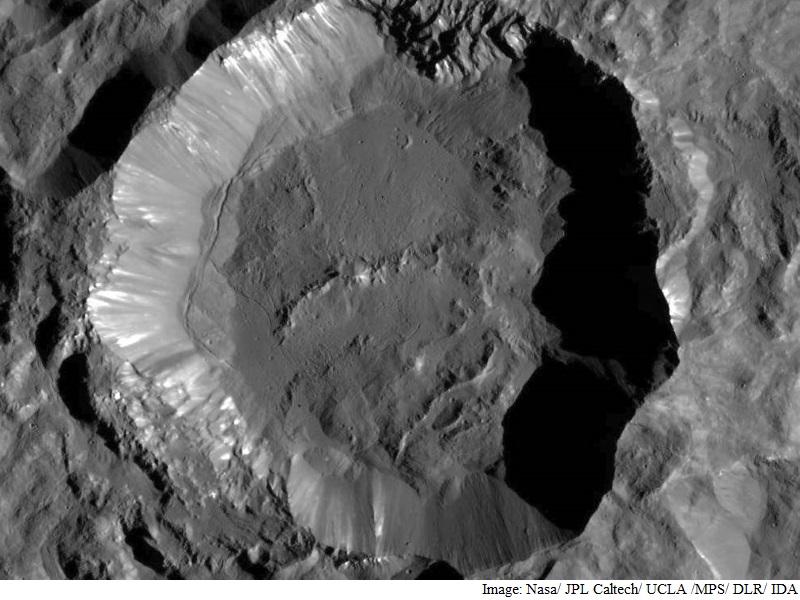- Home
- Science
- Science News
- Nasa's Dawn Probe Reveals Finer Details of Crater on Ceres
Nasa's Dawn Probe Reveals Finer Details of Crater on Ceres

The crater has bright material exposed on its rim which could be salts and its flat floor likely formed from impact melt and debris.
Researchers will be looking closely at whether this material is related to the "bright spots" of Occator Crater.
Kupalo, which measures 26 km across and is located at southern mid-latitudes, is named for the Slavic god of vegetation and harvest.
"This crater and its recently-formed deposits will be a prime target of study for the team as Dawn continues to explore Ceres in its final mapping phase," said Paul Schenk, a Dawn science team member at the Lunar and Planetary Institute, Houston.
Dawn took these images near its current altitude of 385 km from Ceres.
Dawn's low vantage point also captured the dense network of fractures on the floor of 126-km-wide Dantu Crater. One of the youngest large craters on Earth's moon, called Tycho, has similar fractures.
This cracking may have resulted from the cooling of impact melt, or when the crater floor was uplifted after the crater formed.
Dawn's other instruments also began studying Ceres intensively in mid-December last year.
The spacecraft will remain at its current altitude for the rest of its mission, and indefinitely afterward. The end of the prime mission will be June 30, 2016.
Dawn is the first mission to visit a dwarf planet and the first mission outside the Earth-moon system to orbit two distinct solar system targets.
After orbiting another planet Vesta for 14 months in 2011 and 2012, it arrived at Ceres on March 6, 2015.
Catch the latest from the Consumer Electronics Show on Gadgets 360, at our CES 2026 hub.
Related Stories
- Samsung Galaxy Unpacked 2025
- ChatGPT
- Redmi Note 14 Pro+
- iPhone 16
- Apple Vision Pro
- Oneplus 12
- OnePlus Nord CE 3 Lite 5G
- iPhone 13
- Xiaomi 14 Pro
- Oppo Find N3
- Tecno Spark Go (2023)
- Realme V30
- Best Phones Under 25000
- Samsung Galaxy S24 Series
- Cryptocurrency
- iQoo 12
- Samsung Galaxy S24 Ultra
- Giottus
- Samsung Galaxy Z Flip 5
- Apple 'Scary Fast'
- Housefull 5
- GoPro Hero 12 Black Review
- Invincible Season 2
- JioGlass
- HD Ready TV
- Laptop Under 50000
- Smartwatch Under 10000
- Latest Mobile Phones
- Compare Phones
- OPPO Reno 15 Pro Max
- Honor Win RT
- Honor Win
- Xiaomi 17 Ultra Leica Edition
- Xiaomi 17 Ultra
- Huawei Nova 15
- Huawei Nova 15 Pro
- Huawei Nova 15 Ultra
- Asus ProArt P16
- MacBook Pro 14-inch (M5, 2025)
- OPPO Pad Air 5
- Huawei MatePad 11.5 (2026)
- Xiaomi Watch 5
- Huawei Watch 10th Anniversary Edition
- Acerpure Nitro Z Series 100-inch QLED TV
- Samsung 43 Inch LED Ultra HD (4K) Smart TV (UA43UE81AFULXL)
- Asus ROG Ally
- Nintendo Switch Lite
- Haier 1.6 Ton 5 Star Inverter Split AC (HSU19G-MZAID5BN-INV)
- Haier 1.6 Ton 5 Star Inverter Split AC (HSU19G-MZAIM5BN-INV)
















